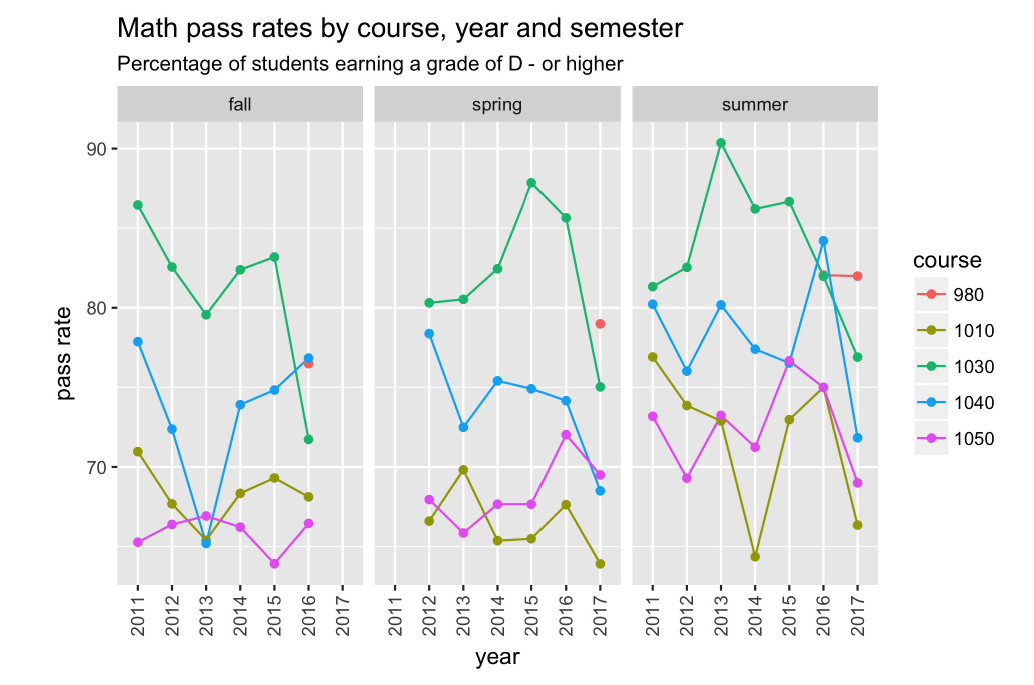Investigating Changes to the Primary Non-STEM Math Course Sequence at SLCC
Prepared by Jeff Webb
AAB 355-Q • 4600 S Redwood Road • (801) 957-4110
September 21, 2017
Abstract
In summer 2016 the math department revised the main course pathway leading to the Quantitative Literacy (QL) graduation requirement. Previously the main pathway was Math 1010 to Math 1050. For many non-STEM students, however, not only was 1010 difficult but 1050 was unnecessarily advanced. Consequently, a new math course sequence—or "mathway"—was developed. A new course, Math 980, replaced 1010 as the primary QL gateway course, and an existing course, Math 1030, replaced 1050 as the primary terminal QL course for non-STEM students. Math 1030 is less algebra-focused than 1050 and has historically higher pass rates. It provides sufficient math training for students not planning to continue on in a STEM field. Non-STEM students, as of summer 2016, are now being advised into this new 980 –> 1030 sequence. (The 1010 –> 1050 sequence still exists for STEM students.) Is this new mathway working? Specifically:
Did QL attainment rates increase? Math 980 was introduced in summer 2016, so we would expect increased QL completion due to Math 980 in fall 2016 at the earliest. However, the entrance requirements for 1030 were relaxed effective summer 2016 as well: more students were eligible to take the revised 1030 course by testing into it. Previously, a score of 40 and above on CPT5 was required; as of fall 2016 a score of 60 or above was required on CPT4. (The entrance requirements for Math 1050 did not change.) This change could have impacted QL completion as early as Fall 2016.
Did course enrollments change in the expected ways? In fall 2016 access to 1030 increased (as noted above), so we would expect that enrollments in 1030 went up. Also students who would previously have taken 1050 (on the 1010 –> 1050 mathway) would ideally have taken 1030 (on the new 980 –> 1030 mathway). So in AY 2016-17 enrollment in Math 1030 should have increased sharply.
Did course performance change? Generally, we would expect greater access in Math 1030 to be associated with lower success. But 1030 was designed to be an easier course than 1050 so although pass rates in 1030 may have gone down the number of students passing a QL course should have gone up.
What was the math retention rate in Math 980 compared to historical rates in 1010? By “retention rate,” we mean the proportion of students who enrolled in a higher math course the semester after passing 1010 or 980. The easier 980 –> 1030 mathway should have increased the willingness of students to persevere to the next math course.
SUMMARY OF FINDINGS
After revision of the mathways in Summer 2016:
Pass rates went down in 1030 but went up in 1050. However, the lower pass rates in 1030 were still higher than those observed in 1050.
Rates of E grades in 1030 increased but W rates stayed about the same. Enrollments went up in 1030 but went down in 1050 as non-STEM students were advised into 1030.
These two facts together—higher pass rate in 1030 along with increased enrollment—resulted in sharp increases in QL rates in Summer 2016 and 2017, Fall 2016 and Spring 2017, compared to historical rates. QL rates increased by about 5-7% in these semesters.
The proportion of students retained into a higher math course the following semester was markedly higher for Math 980 (.44 in Fall 2016) than for Math 1010 (.33 in Fall 2015 and .3 in Fall 2016).
Although the primary new mathway sequence for non-STEM majors is 980 –> 1030, approximately 60% of 980 students retained in spring 2017 enrolled in Math 1010. The same pattern was apparent for 980 students taking Math in summer 2017.

Math pass rates by course, year and semester. For purposes of visualization, pass is defined as D- or above. The change in mathways was effective summer 2016, the first term math 980 was offered. In the case of 1030 we see the trade-off between access and success, as measured by pass rate. In 1030 the pass rates dropped by over 10 points in fall 2016 and spring 2017. However, pass rates in 1030, even with a drop into the low 70 percent range in fall 2016, still remain well above 1050 pass rates.
Rates of quantitative literacy (QL) attainment by term. What was the overall effect on QL attainment as a result of the change, effective 201640, in the CPT cutoff for 1030? The QL rate represented in this plot was calculated as the proportion of those taking and passing Math 1030, Math 1040 or Math 1050 out of all math enrollments per term that resulted in a letter grade (excluding grades of "AU"). Thus, the QL rate, as calculated here, is not equivalent to the pass rate in Math 1030/40/50. Although pass rates in 1030 went down in 201640 compared to previous terms, they remained above 1050 pass rates. Thus, the shift of students from 1050 to 1030 effectively allowed more students to pass a QL course, resulting in a higher QL rate in AY 2016-17.
(requires College login)
